Taubin AG-2 grenade launcher

Taubin’s automatic grenade launcher
In the early 1930s in the Soviet Union, weapons designers took up the solution of such a complex problem as increasing the firepower of infantry, which was possible not only through the widespread use of such a type of automatic weapon as machine guns, but also through the creation of a fundamentally new type of firearm - automatic grenade launchers.

Taubin grenade launcher
At the end of August 1931, a student of the Odessa Institute of Grain and Flour Technology, Yakov Grigorievich Taubin, sent the project of his grenade launcher, which fired standard 40.8-mm Dyakonov grenades, to the Artillery Directorate of the Red Army, where it caught the eye of the Deputy People’s Commissar of Defense for Armament Tukhachevsky. The famous corps commander was seriously interested in the project.
After several months of disputes and bureaucratic delays, Taubin was offered to create a prototype of a grenade launcher at the Kovrov Arms Plant INZ-2. Taubin left the institute and went to Kovrov. In Kovrov, according to Taubin’s drawings, the first two samples of the grenade launcher were manufactured: one with a vertical grenade feed, the other with a horizontal one.
In 1934, from a group of enthusiasts working under the leadership of Taubin, an independent Taubin Design Bureau (KBT) was created, in 1937 renamed OKB-16 of the People’s Commissariat of the Defense Industry. In the same year, KBT moved to Moscow, by the end of the year its team, numbering 50 employees, focused exclusively on the development of a grenade launcher. Under the leadership of Taubin, the design of an automatic grenade launcher began.
The automatics of the first prototype model of the Taubin grenade launcher of the 1935 model worked on the principle of free bolt recoil. In this model, for the first time, magazine loading from a 5-round clip was used, which increased the practical rate of fire. A qualitatively new ammunition was created for the Taubin automatic grenade launcher - a 40.8-mm unitary round with a fragmentation grenade and a waferless case. However, its small powder charge did not ensure the reliable performance of the weapon’s automation, so Taubin had to completely redesign the grenade launcher.
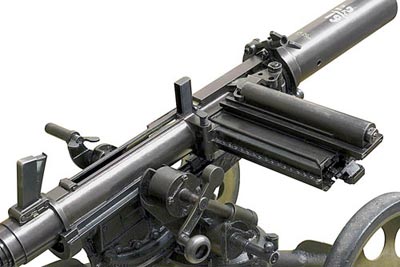
Taubin
grenade launcher (the mechanism of the magazine for five grenades is clearly visible)
To increase the reliability of the gun, a new automatic scheme was introduced in 1936, which worked due to the recoil energy of the barrel during its long stroke.
Initially, the rate of fire of the 40.8-mm grenade launcher was limited by the design of the magazine and did not exceed 50-60 rounds per minute. But Yakov Grigorievich also developed a belt-fed version with a rate of fire of 440-460 rounds per minute. Due to the small charge of the unitary cartridge, the heating of the barrel and its wear during firing were low, and this rate could be maintained until the belt with grenades ran out. On the other hand, the charge was enough to provide a firing range of 1200 m.
Tests of the 40.8-mm grenade launcher were continuously conducted since 1933. Almost every year there were more and more new models, and even small series. So, in 1937 alone, OKB-16 manufactured 12 grenade launchers for military trials, and the Kovrov plant INZ-2 - another 24. At the end of 1937, the 40.8-mm Taubin grenade launcher underwent military tests simultaneously in three rifle divisions. Reviews everywhere were generally positive, the practical rate of fire was brought to 100 rounds per minute (with clip feeding).
In November 1938, the 40.8-mm grenade launcher was tested on a small armored boat of the “D” type of the Dnieper military flotilla. The grenade launcher was installed on the pedestal of the ShVAK machine gun. Firing was carried out both at anchor and on the move. Also, Yakov Taubin’s grenade launcher was tested in NKVD units in the Far East, where it also received positive reviews.
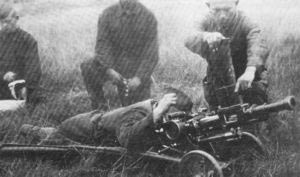
tests of the Taubin
automatic grenade launcher in 1938
By the end of 1938, work on the design of the grenade launcher was completed. Its automation worked satisfactorily, the shot was also fully worked out. The tactical capabilities of the Taubin-Bergoltsev AG-2 automatic grenade launcher were determined at long-term range, and then military tests, which were carried out in January 1940 on the Karelian front during the Soviet-Finnish war by KBT employees Nudelman and Isakov.
During the tests, along with the high efficiency of the use of the new weapon, numerous design flaws were also revealed: low survivability of its individual parts; numerous delays during firing, which occurred due to the fault of automation in difficult working conditions. The shortcomings of this weapon identified during combat operations were taken into account in further work. So, for the reliable operation of the automation of this rather specific weapon, it was necessary to develop a new lubricant that does not freeze at low temperatures, brake fluid for recoil devices, improve steel grades and heat treatment mode for loaded parts of weapons.
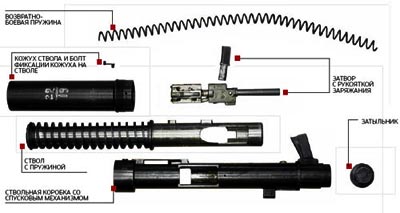
неполная разборка тела гранатомета
Одновременно с проверкой боевых возможностей гранатомета АГ-2 на поле боя проводился анализ его производственно-экономических показателей, который также выявил высокую себестоимость и трудоемкость изготовления оружия из-за широкого применения в его конструкции специальных сортов сталей, обработки многих деталей на станочном металлообрабатывающем оборудовании.
В результате настойчивой работы всего коллектива КБТ над комплексом “боеприпас - гранатомет - прицел - станок” автоматический гранатомет Таубина-Бергольцева-Бабурина был создан. Над новым вариантом гранатометного комплекса АГ-2 образца 1938 года работала конструкторская группа в составе Я. Таубина, М.Бергольцева, М.Бабурина, С.Рашкова, А.Нудельмана и П.Грибкова.
Автоматика второй модели автоматического гранатомета АГ-2 работала по принципу отдачи при длинном ходе ствола с запиранием канала ствола поршневым затвором. Теперь даже с малым вышибным пороховым зарядом автоматика работала надежно. Питание боеприпасами осуществлялось из пятизарядного магазина, вставлявшегося сверху в приемник ствольной коробки.
Тело гранатомета конструировали Я. Г. Таубин, М.Е. Бергольцев и М.Н. Бабурин. Оно состоит из ствола со съемным кожухом, затвора, возвратно-боевой пружины и затыльника.
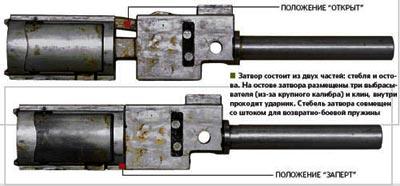
затвор гранатомета Таубина
Затвор состоит из двух частей: стебля и остова. На остове затвора размещены три выбрасывателя (из-за крупного калибра) и клин, внутри проходит ударник. Стебель затвора совмещен со штоком для возвратно-боевой пружины.
Изначально 40,8-мм гранатомет комплектовался неудобным при транспортировке треножным станком. В 1936 году Нудельманом и Грибковым был создан пехотный колесный станок, близкий по конструкции к станку легендарного пулемета Максима. Однако вес оставался запредельным для пехотинца - 73 кг. После модернизации станка его вес был снижен до 45,5 кг, а к 1939 году общий вес гранатомета доведен до приемлемых 38 кг. Причем снижение веса орудия не ухудшило его огневой мощи. Гранатомет легко разбирался и переносился вручную на поле боя, а зимой установку ставили на лыжи.
Расчет гранатомета состоял из 2 человек.
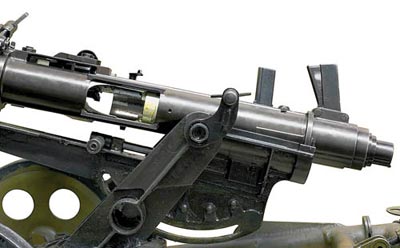
Вид гранатомета слева со взведенным затвором.
В открытое окно ствольной коробки вкладывался первый выстрел
при заряжании оружия. Снизу видна рукоятка взведения затвора.
Автоматические гранатометы АГ-2 первоначально планировалось использовать для вооружения сухопутных войск в целях усиления огня в тактическом звене взвод - рота. Для решения многих задач пехотные подразделения, имевшие подобные гранатометы на вооружении, смогли бы на дальностях до 2 - 3,5 км практически полностью обходиться своими силами без привлечения батальонной и полковой артиллерии.
Кроме того, еще в 1935 году Я. Таубин задумал повысить маневренность этого оружия, установив гранатомет на армейский мотоцикл. В 1937 году в КБТ был разработан экспериментальный образец мотоцикла с двумя симметрично расположенными колясками, на одну из которых устанавливался гранатомет. Но эта идея не была до конца реализована.
Также ОКБ-16 разработало по заказу ВВС и изготовило авиационный вариант гранатомета под ленточное питание на 15 - 20 выстрелов. Два авиационных автоматических гранатомета были смонтированы в крыльевых установках самолета. Но после проведения летных испытаний работы над ними были прекращены.
Уже по результатам войсковых испытаний конца 1937 года гранатомет следовало принять на вооружение РККА. Все отмеченные недостатки были несерьезны и устранимы. Однако Таубин «перешел дорогу» “минометчикам”. Они сочли, что гранатомет Таубина ставит под сомнение продолжение работ по 50-мм ротным минометам, а возможно, и по 60-мм и 82-мм минометам. “Минометчики” добились от Артуправления фантастического по своей глупости решения - испытывать 40,8-мм гранатомет вместе с 50-мм минометом, причем по программе стрельбы миномета.
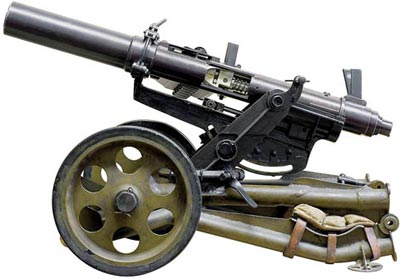
гранатомет Таубина
In February 1939, comparative field tests of the Taubin-Bergoltsev AG-2 grenade launcher and the Osa mortar by B. Shavyrin were carried out in the presence of the People’s Commissar of Defense of the USSR K. Voroshilov and a large group of Red Army commanders. The grenade launcher and mortar worked normally. Although the grenade launcher could not compete with the mortar in terms of the results of mounted fire, especially at short ranges, it surpassed it in the rate of fire and accuracy of aimed fire at all ranges. Naturally, the mortar could not conduct flat firing, and it was not in the program, and the grenade launcher could effectively conduct both flat and mounted firing. But at the maximum elevation angle, the accuracy of fire of the 50-mm mortar turned out to be slightly better. In addition, the mortar was much simpler and cheaper than the grenade launcher. The result of the tests was the adoption of a 50-mm company mortar of the 1938 model in the same year. The “mortarmen” won - the 50-mm mortar was put into mass production. But already at the very beginning of the Great Patriotic War, the 50-mm mortar proved to be an insufficiently effective weapon and was withdrawn from production and service.
| Caliber, mm | 40,8 |
|---|---|
| Grenade weight, kg | 0,59 |
| Maximum | |
| firing range, m | 1250 |
| Rate of fire, rds/min | 436 |
| Practical rate of fire, | |
| rounds/min | 57 |
| Weight in firing position, kg | 45,5 |
It should be noted that the cost of the grenade launcher was relatively high, because it was manufactured by a semi-artisanal method in OKB-16, but after the launch of the grenade launcher into mass production, it should have fallen several times. Naturally, the “childhood diseases” of the grenade launcher such as weakness of the barrel springs, extractor and ejector would have been done away with in the course of serial production. This is how most weapons systems were brought in the Soviet Union.
In addition, Marshal G. Kulik, who as Deputy People’s Commissar of Defense, oversaw the direction of new developments of artillery and small arms, was an opponent of the adoption of the grenade launcher. Kulik’s stubborn reluctance to adopt the AG-2 automatic grenade launcher and open hostility to its designer eventually led to a complete cessation of work on a new weapon, the arrest and execution in 1941 of Taubin himself, accused of sabotage and sabotage.
Weapons of this type were created only thirty years later, but at a qualitatively different level. The design of the Taubin-Bergoltsev automatic grenade launcher had a serious impact on the further development of infantry weapons, and not only in Russia.